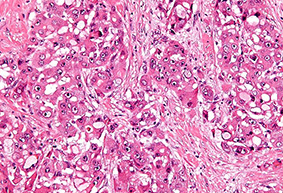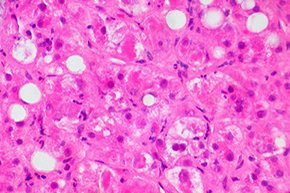News
News Articles 41 - 50 of 160
Sep
Read more
While six weeks of sofosbuvir and ribavirin therapy was safe and well tolerated in HCV patients, its efficacy was sub-optimal, a study concluded.
In this open-label study conducted in Australia and New Zealand, 19 adults with recent HCV (68% genotype 1; duration of infection median 37 weeks) received sofosbuvir 400mg daily and weight-based ribavirin for six weeks.
Four reported a symptomatic HCV seroconversion illness, including two with jaundice. At baseline, the median HCV RNA was 5.4 log10 IU/mL and at the end-of-treatment, it was non-quantifiable in 89%. SVR4 and SVR12 were 42% and 32%, respectively.
Treatment failure was because of non-response in two, post-treatment relapse in nine, re-infection in one, and with one loss to follow up.
The regimen was well tolerated with minimal haematological toxicity. SVR12 was related to baseline HCV RNA (≤6 log10 IU/mL, p=0.018) and early on-treatment viral kinetics.
The researchers suggest that further research is needed to determine whether more potent interferon-free direct-acting antiviral regimens will allow treatment duration to be shortened in recent, predominantly asymptomatic, HCV infection.
Reference
Sofosbuvir and ribavirin for six weeks is not effective among people with recent HCV infection: The DARE-C II study. Martinello M, Gane E, Hellard M et al. Hepatology. 2016 Sep 17 [Epub ahead of print]
Sep
Read more
A small number of UK citizens are undergoing liver transplants abroad but their management is of a lower standard than in the UK.
These were the conclusions of researchers at Sheffield’s Royal Hallamshire Hospital, who sent questionnaires to all seven UK liver transplant units enquiring about liver patients receiving transplant abroad. Six of the seven centres responded.
A total of 12 patients were identified as having undergone liver transplantation overseas. The top destinations were India, China and Egypt.
Four units responded to questions regarding pre-transplant screening. One unit reported HBV and HCV screening not taking place. Four units responded to questions regarding post-transplant antimicrobial therapy. This revealed examples of patients inappropriately not receiving valganciclovir, co-trimoxazole, anti-fungal treatment and HBV immunoglobulins.
The researchers add that information transfer between overseas and UK based transplant teams is poor.
Reference
A questionnaire based assessment of numbers, motivation and medical care of UK patients undergoing liver transplant abroad. Winter BK, Odedra A, Green S. Travel Med Infect Dis. 2016 Sep 14 [Epub ahead of print]
Sep
Read more
More than a third of vulnerable people screened for HBV, HCV, HIV and syphilis at out-of-hospital sites, did not return for result, a study in Paris has revealed.
Researchers at nine out-of-hospital screening mobile sites in Paris explored the rates of these infections amongst 341 vulnerable people who were mostly intravenous drug users, sex workers or homeless.
The proportion of failure to return for results was 38.75%. In multivariate analysis, unemployment was significantly associated with failure to return (odds ratio 4.29), as well as having been screened in the past (odds ratio 4.32). And 18.03% of the patients had a false perception of an immunization against HBV.
In multivariate analysis, having a place of residence protected against a false perception (odds ratio 0.33), while being screened in the past enhanced the risk of a false perception (odds ratio 3.28).
The researchers suggest that using technologies, such as phone texting, might be a partial solution along with rapid diagnostic tests. More information and explanation of the results should be provided, along with specific anti-HBV vaccination campaigns targeting these specific populations.
Reference
Out-of-hospital screening for HIV, HBV, HCV and syphilis in a vulnerable population, a public health challenge. Legoupil C, Peltier A, Henry Kagan V et al. AIDS Care. 2016 Sep 14:1-3 [Epub ahead of print]

Sep
Read more
Liver transplant patients who receive subsequent cardiac surgery have acceptable short-term and long-term outcomes, researchers have concluded.
The researchers, from the University of Alabama at Birmingham School of Medicine, analysed data on 43 patients (median age 60) who underwent cardiac operations at 63 months, on average, after their liver transplants.
There were three operative deaths and 24 late deaths. The patients with a preoperative Model for End-Stage Liver Disease (MELD) score of 13.8 or less had significantly greater survival rates than those with a MELD score greater than 13.8. Patients with a postoperative MELD score of 17 or less had significantly greater survival rates than those with a MELD score greater than 17.
Further analyses showed that postoperative peak creatinine levels were statistically significant predictors of death (relative risk 1.8). The one, five, and 10 year Kaplan-Meier survival rates were 90%, 51%, and 35%, respectively; postoperative mortality rates followed a constant phase model with a hazard of death of 10% per year.
Reference
Outcomes of patients who undergo cardiac surgical procedures after liver transplantation. Harrington PB, McAlexander WW, Bryant AS et al. Ann Thorac Surg. 2016 Sep 9 [Epub ahead of print]

Sep
Read more
Elderly patients with advanced hepatocellular carcinoma (HCC) who were treated with sorafenib had similar clinical outcomes and toxicity rates to their younger counterparts, according to a UK study.
A total of 190 HCC patients who were treated with sorafenib at King's College Hospital, London, were divided into two groups: (A) 151 patients aged up to 75 and (B) 39 patients older than 75.
There was no significant difference in overall survival (OS) and time to treatment failure (TTF) between the two groups (7.1 months versus 10.4 months; and 4.2 months versus 5.6 months, respectively). The incidence of toxicities at all grades and dose reductions were comparable between the two groups.
In a multivariate setting, patients with Child-Pugh B scores at baseline were associated with a higher risk of death (adjusted hazard ratio 2.17) and treatment failure (adjusted hazard ratio 4.64) and had shorter OS and TTF compared with patients with a Child-Pugh A.
The researchers concluded that age alone should not be a discriminating factor for the management of advanced HCC with sorafenib.
Reference
Efficacy and safety of sorafenib in patients with advanced hepatocellular carcinoma: age is not a problem. Ziogas DC, Papadatos-Pastos D, Thillai K et al. Eur J Gastroenterol Hepatol. 2016 Sep 10 [Epub ahead of print]

Sep
Read more
Researchers have reported a high rate of HBV breakthrough amongst elderly non-Hodgkin lymphoma (NHL) patients receiving rituximab-based chemotherapy.
The researchers, at Milan’s Luigi Sacco Hospital, evaluated 85 newly diagnosed NHL patients aged over 65 with resolved HBV infection who received rituximab-containing chemotherapies. All received lamivudine. HBV DNA was checked at baseline, every four weeks, for one year after completing the rituximab containing regimens.
Nine patients had HBV reactivation and HBV-related hepatitis. All received entecavir and recovered without consequences. HBV reactivation was more likely to occur after an average of five R-CHOP cycles or during fludarabine.
The researchers concluded that the rate of viral breakthrough was high, considering that the patients were HBV DNA negative at baseline. They suggested that lamivudine prevention may not be sufficient in this population.
Reference
High rate of hepatitis B viral breakthrough in elderly non-Hodgkin lymphomas patients treated with Rituximab based chemotherapy. Castelli R, Ferraris L, Pantaleo G et al. Dig Liver Dis. 2016 Aug 20 [Epub ahead of print]

Sep
Read more
A new US study suggests patients with HCV appear to be highly satisfied with the treatment provided by clinical pharmacists.
Researchers at the University of Massachusetts Medical School offered an anonymous patient satisfaction survey to patients who were initiating or receiving HCV treatment under the care of a clinical pharmacist.
Sixty-four patients completed 77 (24 pharmacist and 53 prescriber) patient satisfaction surveys. The patients reported high levels of satisfaction with the pharmacist and prescribers. All 24 patients ranked overall satisfaction with services provided by pharmacists as 'great', and 36 of 52 patients ranked overall satisfaction with services provided by prescribers as 'great'. Patients supported the inclusion of a clinical pharmacist on health care teams for other disease states.
Reference
Patient satisfaction with the clinical pharmacist and prescribers during hepatitis C virus management. Martin MT, Faber DM. J Clin Pharm Ther. 2016 Aug 31 [Epub ahead of print
]
Sep
Read more
A new study has not found any mother-to-child transmission of HCV among patients attending a dental hospital in Scotland.
The study was undertaken among children, accompanying parents and household contacts attending a general anaesthetic assessment clinic at Glasgow Dental Hospital and School. Children were asked to provide an oral fluid specimen for HCV testing. Accompanying adults were asked to provide demographic data on the child and information on familial risk factors for HCV infection using a standardised questionnaire. Birth mothers were also asked to provide an oral fluid specimen.
Between June 2009 and December 2011, samples were collected from 2,141 children and 1,698 mothers. None of the samples from the children were HCV seropositive but 16 (0.9%) of the specimens from mothers were HCV antibody positive.
The researchers summarised that the prevalence of HCV seropositivity in the birth mothers of the children was similar to that estimated in the general population served by the hospital and showed no evidence of mother-to-child transmission of HCV.
Reference
The seroprevalence of hepatitis C virus infection among children and their mothers attending for dental care in Glasgow, Scotland, United Kingdom. O'Leary M, Bagg J, Welbury R et al. J Infect Public Health. 2016 Aug 24 [Epub ahead of print]

Sep
Read more
The prevalence of non-alcoholic fatty liver disease (NAFLD) and the rate of advanced fibrosis are significantly high among individuals with metabolic abnormalities, a new study found.
Among 11,674 individuals in NHANES III, a large United States population database, the prevalence of NAFLD was 18.2%. Individuals with metabolic abnormalities demonstrated a higher prevalence. These included metabolic syndrome (43.2%), increased waist circumference (31.2%), impaired fasting glucose/diabetes (41.2%), high triglyceride level (34.7%), low high-density lipoprotein (27.8%), and high blood pressure (29.2%).
The individuals with metabolic syndrome had significantly higher NAFLD prevalence compared with controls (adjusted odds ratio 11.5). The severity of hepatic steatosis increased with higher number of metabolic abnormalities. Among individual metabolic abnormalities, increased waist circumference, impaired fasting glucose/diabetes, high triglyceride, and low high-density lipoprotein levels were found to be independently associated with NAFLD.
Individuals with impaired fasting glucose/diabetes and those with five metabolic abnormalities had higher rates of advanced fibrosis (18.6% and 30.3%, respectively). The prevalence of NAFLD among individuals without any metabolic abnormalities was 6.1%.
Reference
The association between nonalcoholic fatty liver disease and metabolic abnormalities in the United States population. Jinjuvadia R, Antaki F, Lohia P et al. J Clin Gastroenterol. 2016 Aug 31. [Epub ahead of print]

Sep
Read more
A UK study showed outreach testing and treating HCV in a drug treatment unit (DTU) could be both feasible and cost effective.
All persons attending a London DTU were offered HCV testing, and where appropriate follow-up and treatment by a specialist nurse at the DTU. Of 321 persons eligible, 216 were screened, 89 were HCV positive and 66 had confirmatory evidence of viraemia. All were infected with either HCV genotype 1 or 3.
Treatment was initiated in 29 people, 22 with interferon-based regimens and seven with direct-acting antiviral only treatments. Following initial treatment 21 (72%) achieved SVR12.
The study authors, from Imperial College, London, estimated that the programme represented an average per-patient cost-saving of £2,498 and a quality-adjusted life year (QALY) gain of 4.10 over a lifetime. In a hypothetical scenario of all oral DAA treatment, an incremental cost per QALY of £1,029 was estimated.
Reference
The cost impact of outreach testing and treatment for hepatitis C in an urban drug treatment unit. Selvapatt N, Ward T, Harrison L et al. Liver Int. 2016 Aug 27 [Epub ahead of print]


